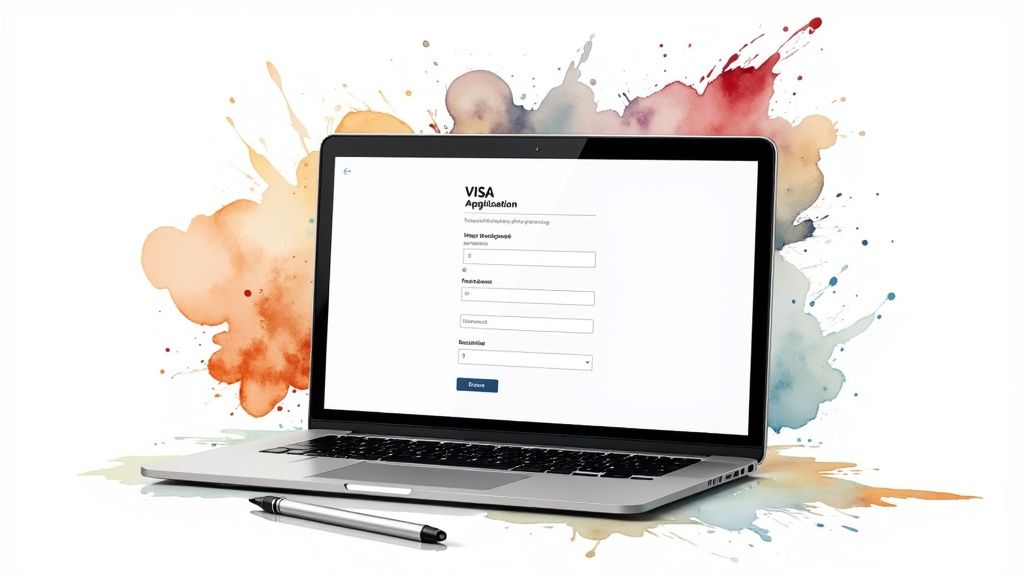At their core, the requirements for most digital nomad visas rest on four key pillars: showing you have a stable income from outside the country, proving you have valid health insurance for your stay, verifying your remote work status, and having a clean criminal record. While the nitty-gritty details change from one country to the next, getting these four things in order is the foundation for almost any successful application.
Why Digital Nomad Visas Are Reshaping Global Work
The explosion of digital nomad visas isn’t just some passing fad; it signals a major shift in how governments think about talent and economic growth. It’s best to see these visas less like a long-term tourist pass and more like a formal invitation. A country is essentially rolling out the welcome mat for a self-sufficient professional who can contribute to the local economy without taking a local job. This creates a genuine win-win that’s changing the game for global work and travel.
For the nomad, it’s a game-changer. You get the legal right to live and work somewhere new, offering stability that goes far beyond the usual 90-day tourist visa shuffle. But for the host country, the upside is even bigger. Digital nomads bring their foreign-earned salaries and spend them on local rent, groceries, restaurants, and weekend trips, pumping fresh cash directly into the community.
The Economic Engine Driving Visa Programs
Let’s be real: governments are strategic. They’ve identified digital nomads as a low-risk, high-reward group of people. These professionals show up with their own income, often filling up apartments in the off-season and propping up local cafes and shops all year long. They don’t put a strain on the local job market—they stimulate it. This powerful economic incentive is the main reason we’re seeing these visa programs pop up all over the world.
This has sparked a bit of a friendly competition, with countries designing programs to lure in the best remote talent. Some are offering attractive tax breaks, others are creating clear paths to long-term residency, and many are simply highlighting their fantastic quality of life and rock-solid internet. This global race is fantastic news for anyone with a remote job and a passport. It means more choices, better visa terms, and a more welcoming legal landscape than ever before. Since many nomads are part of larger remote organizations, it’s worth checking out some of the best practices for virtual teams.
The core idea is brilliantly simple: let’s attract people who earn their money somewhere else but spend it right here. This model helps countries grow their GDP, support small businesses, and add a diverse, skilled population to their communities without overtaxing their public systems.
A Rapidly Expanding Global Network
The growth of these visa programs has been incredibly fast and widespread, showing just how seriously governments are taking this new reality of work. The global map for remote workers is expanding at a breakneck pace; by 2025, it’s expected that over 70 countries will have some version of a digital nomad visa or remote work residency program. These initiatives give nomads the legal green light to live and work for anywhere from six months to, in some cases, up to 10 years.
Take Thailand, for example. Its Long-Term Resident (LTR) visa can extend for a full decade for high-earning professionals. Spain offers an initial one-year visa that can be renewed for up to five years. Meanwhile, countries like Colombia have made it incredibly accessible, with an income requirement of around just $900 per month for its two-year visa, while Mexico’s temporary resident visa lets you stick around for up to four years. This global movement, supercharged by tech like satellite internet, is a clear sign that countries are actively recruiting remote talent to boost their local economies.
Your Essential Digital Nomad Visa Checklist

Trying to figure out digital nomad visa requirements can feel like you’ve been handed a puzzle with half the pieces missing. But here’s the good news: nearly every country bases its visa on the same core principles. Once you get these down, you’ll have a universal checklist that works almost anywhere you want to set up your laptop.
Think of it like building a table. You need four strong legs for it to be stable. If one is shaky, the whole thing might collapse. Your application works the same way. Let’s break down exactly what you need to gather to build a solid case for each of these four pillars.
Pillar 1: Proof of Financial Stability
This is the big one. Almost every consulate will zoom in on your proof of income. They aren’t just looking for a healthy bank balance; they need to see a stable and consistent flow of money coming from outside their country. A one-time, large deposit looks fishy. What they want to see is reliable, regular income from your clients or employer.
Countries have income thresholds for a reason: they need to know you can support yourself without taking a local job or leaning on their social safety nets. For instance, Portugal’s D8 visa requires a monthly income of at least four times the national minimum wage, which works out to about €3,480 per month as of 2025.
To prove your financial stability, you’ll want to pull together:
- Bank Statements: At least 6 to 12 months of statements showing those regular income deposits.
- Employment Contract: If you’re an employee, a signed contract that clearly states your remote role and salary is essential.
- Client Invoices & Agreements: Freelancers should prepare a portfolio of contracts and paid invoices to demonstrate a steady stream of work.
- Tax Returns: Your most recent tax returns offer an official snapshot of your annual earnings.
The goal is to paint a clear picture of self-sufficiency. Your documents should tell a simple story: “I make a steady remote income and will continue to do so while I live here.”
Pillar 2: Verification of Your Remote Work
Next up, you have to prove your work is genuinely remote. This is how countries filter out digital nomads from people who might try to find local work illegally. You must show that your employer or your clients are based outside the country you’re applying to. It’s a non-negotiable part of the deal.
This is where your professional paperwork comes in. If you’re still looking for a solid remote gig to build this proof, our guide on how to find remote work has some great strategies.
If you’re employed, a letter from your HR department is pure gold. It needs to state explicitly that your job is 100% remote and that you have permission to work abroad. For freelancers and business owners, this means showing things like your business registration and contracts with foreign clients.
Pillar 3: Comprehensive Health Insurance
No country wants to be on the hook for your medical bills. That’s why proof of comprehensive health insurance is an absolute must. Your standard travel insurance policy won’t cut it here—those usually only cover short-term emergencies and will almost certainly be rejected.
You need a robust policy that covers you for the entire length of your visa. It should generally include:
- Emergency medical care and hospitalization.
- Repatriation (this covers the cost of sending you home if something serious happens).
- High enough coverage limits, often at least €30,000, as specified by the embassy or consulate.
Pillar 4: A Clean Criminal Record
Finally, you’ll need to prove you’re not a security risk by providing a criminal background check. This is standard procedure for almost any long-stay visa. You’ll need to get an official, certified copy from your home country, and often from any other country where you’ve lived for more than six months in the past few years.
Don’t leave this to the last minute! The process can take several weeks, so start on it early. Make sure the document is recent (usually issued within the last 3 to 6 months) and get it apostilled or officially translated if the consulate requires it.
While every country has its own unique spin on the digital nomad visa, most applications are built on these common requirements. To help you get organized, here’s a quick checklist of the documents you’ll almost always need to prepare.
Common Digital Nomad Visa Requirements Checklist
| Requirement Category | What It Is | Common Pitfall to Avoid |
|---|---|---|
| Proof of Income | Bank statements, employment contracts, or client invoices showing stable, recurring income. | Showing a single large deposit instead of consistent, monthly payments. |
| Remote Work Verification | A letter from an employer or business documents proving your work is not tied to the destination country. | Vague letters that don’t explicitly state your role is 100% remote. |
| Health Insurance | A comprehensive health insurance policy valid for the entire visa duration with sufficient coverage. | Submitting a standard travel insurance policy, which is usually inadequate. |
| Criminal Record Check | An official background check from your home country (and others where you’ve lived). | Applying for it too late, as processing can take several weeks. |
| Valid Passport | Your passport must be valid for the entire visa duration, plus an extra 6 months. | An expiring passport that won’t cover your intended length of stay. |
| Application Form | The official, fully completed visa application form for the specific country. | Leaving fields blank or providing inconsistent information across documents. |
Getting these core documents in order is more than half the battle. It puts you in a fantastic position to tackle any country-specific requirements that come your way, turning a potentially overwhelming process into a manageable one.
What to Expect During the Application Process

Alright, you’ve got your documents lined up and you’re ready to go. This is where the real journey begins. The actual application process for a digital nomad visa can feel like a total black box, a maze of bureaucratic hurdles and long waits that leaves you guessing. It’s perfectly normal to wonder what your chances are and what it all really looks like on the ground.
Think of it like this: you’ve done all your training for a marathon by gathering your documents. Now, it’s race day. Knowing the course—the common obstacles, timelines, and strategies—can be the difference between crossing that finish line and getting tripped up by a technicality you never saw coming.
This is more than just filling out forms. It’s a game of strategy. A little extra care and meticulous prep work can dramatically improve your odds, turning what feels like a bureaucratic nightmare into a manageable project with a life-changing prize at the end.
Where to Apply From and Typical Processing Times
So, first things first: where do you actually submit this mountain of paperwork? For almost every digital nomad visa, you have to apply from your home country or a country where you hold legal residency. The dream of applying from inside your destination country while sipping a coffee on a tourist visa is, unfortunately, very rare.
Always, and I mean always, double-check the specific rules of the embassy or consulate you’re dealing with. Some are fine with mail-in applications, but others will require you to show up for an in-person appointment.
Now for the part that causes the most anxiety: processing times. They can be all over the map. While a few countries are surprisingly zippy, you should realistically budget for a wait of 8 to 12 weeks. For hotspots like Portugal, the sheer volume of applicants can create serious backlogs, so getting your application in as early as you possibly can is your best move.
Here’s a common mistake that trips people up: assuming the countdown starts the moment you drop your package in the mail. The processing clock officially begins only after the consulate accepts your application as complete. Any missing document can reset that timer, pushing your dream trip back by weeks or even months.
Understanding Your Chances of Approval
So, what are your real odds of getting that stamp of approval? While countries don’t exactly broadcast their approval rates in real-time, we can get a pretty solid picture from immigration lawyers and data reported by the nomad community.
Recent numbers from early 2025 paint a picture of a competitive, but not impossible, landscape. Out of nearly 3,000 digital nomad visa applications submitted globally in one snapshot, the average approval rate was about 58%. This tells us that while demand is high, a solid application has a real fighting chance.
For instance, Croatia had a 48.8% approval rate in early 2023, and Cyprus burned through all 500 of its available visas by February 2024 due to intense demand. These figures hammer home one point: nailing every single requirement is absolutely critical. If you’re curious, you can dig into more detailed visa approval statistics to see how different countries stack up.
How to Make Your Application Stand Out
With approval rates often floating around the 50-60% mark, just meeting the bare minimum isn’t enough. You need to build a case that’s impossible to ignore.
Here’s how you can give your application the best possible shot at success:
- Create a Professional Dossier: Don’t just throw a pile of papers in an envelope. Organize them neatly, maybe even with a cover letter that briefly summarizes your application. You want the consular officer to immediately see you as a serious, well-organized candidate.
- Go Above and Beyond on Income Proof: If the minimum monthly income is $3,000 and you make $4,000, show them the $4,000. Exceeding the minimum requirement is the best way to prove your financial stability and reduce any perceived risk.
- Write a Compelling Letter of Intent: This is your chance to be a human, not just a number. Briefly explain why you’re so excited about their country and reaffirm that you’ll respect local laws and work only for your foreign clients or employer. That small personal touch can make a huge difference.
Comparing Top Digital Nomad Visa Programs

Now that we’ve covered the general paperwork and prerequisites, it’s time for the fun part: picking your destination. Moving from theory to reality means looking past the stunning Instagram photos and getting real about what makes a country a good fit for you.
Choosing the right digital nomad visa is a matchmaking process. You have to find the program that aligns with your income, lifestyle, and long-term ambitions. Some visas are incredibly welcoming with low financial bars, while others ask for more but roll out the red carpet with tax breaks or a clear shot at long-term residency.
Let’s break down some of the most popular players—Portugal, Spain, Croatia, and Colombia—to see how they really compare.
Portugal: A Clear Path to EU Residency
Portugal’s D8 Digital Nomad Visa has become a massive favorite in the community, and for good reason. It’s uniquely flexible, offering both a short-term visa for up to a year and a residence visa that you can renew for up to five years. That second option is the real prize, as it puts you on a direct path to permanent residency and, eventually, EU citizenship.
To get your foot in the door, you’ll need to prove a steady income of at least four times the Portuguese minimum wage. As of 2025, that comes out to about €3,480 per month. It’s not pocket change, but the long-term rewards are hard to beat.
- Income Requirement: Around €3,480/month.
- Visa Validity: Up to 1 year (temporary) or 1 year, renewable up to 5 years (residency).
- Key Benefit: An established and straightforward route to EU permanent residency and citizenship.
- Tax Situation: Spend more than 183 days, and you’re a tax resident. Portugal’s new Incentivised Tax Status (ITS) program can be a huge win, offering a flat 20% tax rate on eligible professional income for those who qualify.
Spain: Favorable Taxes for High Earners
Spain’s program is tailored for more established remote professionals who are pulling in a higher income. The financial requirement is steeper, demanding proof that you earn 200% of Spain’s minimum interprofessional salary (SMI). For a single applicant, this works out to roughly €2,520 per month.
But here’s the kicker: the tax situation is fantastic. Approved nomads are taxed as non-residents, meaning you pay a flat 24% on your Spanish-sourced income up to a whopping €600,000. This is a massive discount compared to the country’s normal, much higher progressive tax rates.
Spain’s visa is a strategic move for anyone who can comfortably clear the income hurdle. The trade-off for the higher financial bar is one of the most attractive tax setups in Europe, making it a powerful tool for building wealth while living the good life.
Croatia: Simplicity and Schengen Access
If you’re looking for a straightforward, no-fuss option, Croatia is calling your name. It offers a temporary residence permit for up to one year. The one catch is that you can’t renew it immediately—you have to leave the country for six months before you can reapply. This setup makes it perfect for a year-long European adventure rather than a permanent relocation.
The financial bar is much more approachable, too. You just need to show a monthly income of at least €2,539.31 or prove you have a lump sum of €30,471.72 in the bank to cover your 12-month stay. Since Croatia joined the Schengen Area in 2023, this permit is your golden ticket to travel freely across all 27 Schengen countries.
Best of all? If your income comes from a foreign company, you are not required to pay any income tax in Croatia.
Colombia: The Lowest Barrier to Entry in Latin America
For anyone dreaming of an affordable and vibrant base in South America, Colombia’s digital nomad visa is a game-changer. It has one of the lowest income requirements on the planet, asking for just three times the Colombian minimum wage. That’s roughly $900 USD per month.
The visa is valid for up to two years and the application process is known for being relatively quick and painless. While it doesn’t lead directly to permanent residency, it gives you a stable, long-term launchpad in a country famous for its incredible biodiversity, low cost of living, and warm, welcoming culture. For tax purposes, you’ll generally become a resident after spending more than 183 days in the country.
Digital Nomad Visa Programs At-a-Glance
Sometimes, you just need to see it all laid out. This table cuts through the noise and compares the key details of these popular programs side-by-side.
| Country | Monthly Income Requirement (USD) | Visa Validity & Renewal | Key Benefit |
|---|---|---|---|
| Portugal | ~$3,750 | Renewable up to 5 years | Clear path to EU residency and citizenship. |
| Spain | ~$2,700 | Renewable up to 5 years | Favorable 24% flat tax rate for nomads. |
| Croatia | ~$2,700 | 1 year (non-renewable) | Tax exemption on foreign income and Schengen access. |
| Colombia | ~$900 | Up to 2 years | Extremely low income threshold and low cost of living. |
As you can see, choosing the right program means digging into these crucial details. Your income, long-term goals, and how you feel about taxes will ultimately point you toward the perfect fit. And if you’re thinking even bigger than a temporary visa, it’s worth exploring long-term residency options. For example, looking into the Dubai Golden Visa requirements can open your eyes to what’s possible for permanent settlement in the UAE.
Common Mistakes That Get Applications Rejected

Learning from the mistakes of others is one of the best shortcuts you can take, especially when you’re dealing with demanding digital nomad visa requirements. It’s a frustrating truth that even a tiny oversight can get your application tossed in the rejection pile, costing you time, money, and a whole lot of stress.
Think of your application like a chain. Just one weak link—a missing document, a shaky income statement—is all it takes for the whole thing to snap. Consular officers see hundreds of these, and they’re trained to spot inconsistencies and red flags in seconds.
Underestimating The Income Proof
This is probably the single most common reason for rejection. So many applicants focus on showing enough income, but they forget to prove that it’s stable.
Take Maria, a freelance designer applying for a visa that required a €2,500 monthly income. She’d made €10,000 in the last three months—great, right? But it all came from one big project. The consulate saw that as a one-off payment, not a reliable income stream. Her application hit a wall because it didn’t tell a story of consistent financial stability. You can avoid this by providing 6-12 months of bank statements showing regular, predictable deposits.
Submitting The Wrong Health Insurance
Here’s another classic blunder: confusing cheap travel insurance with the comprehensive health coverage needed for a long-stay visa.
Consider Alex, a remote worker who was so excited he bought a top-of-the-line travel insurance policy for his year-long adventure. His application was denied almost immediately. Why? Travel insurance is for short-term emergencies, not long-term healthcare. Consulates demand a policy that covers everything from hospitalization to repatriation for your entire stay. It also needs to explicitly name the country you’re applying to.
The rule of thumb is simple: if a policy is marketed for tourists on a two-week vacation, it’s almost definitely not what you need. You need a long-term health plan.
Incomplete Or Incorrect Documentation
Bureaucracy runs on precision. A missing signature, a document that hasn’t been apostilled, or even a single blank field on a form can be grounds for immediate rejection. For example, a criminal record check that’s older than the required 3-6 month window is a surprisingly frequent reason for denial.
Even when you’re careful, mistakes can slip through. Knowing what to do when they happen is a critical skill for any visa process. This guide on how to fix common application mistakes is a good starting point, as it drives home the importance of triple-checking every last detail.
A Vague Proof Of Remote Work
Your proof of remote work has to be airtight. A vague letter from your employer is a huge red flag for consular officials.
Look at Ben’s situation. His employer gave him a letter that just said he “works for the company.” It didn’t specify that his role was 100% remote or that he had permission to work from that country. For all the consulate knew, he was planning to look for a local job. That ambiguity got him rejected. The letter must explicitly state your remote status, salary, and that the company is fully on board with your plans. This is just one of many things to consider about the remote lifestyle, and you can dive deeper into the remote work pros and cons in our detailed guide.
By sidestepping these all-too-common errors, you can turn your application from a hopeful gamble into a polished, professional submission that’s built to succeed.
Your Next Steps to Working Abroad
You’ve just untangled the world of digital nomad visas, from the universal must-haves to the nitty-gritty details of specific countries. What once felt like a maze should now look like a clear path forward. Your dream of working from anywhere is so much closer, built on a solid foundation of smart planning.
Think back to the core pillars we covered: proving you have a steady remote income, locking in comprehensive health insurance, and showing a clean criminal record. Getting these fundamentals right is your first and most important move.
From there, it’s all about matching your profile to the perfect destination. Whether you’re drawn to Portugal’s residency-focused visa or Colombia’s more accessible entry requirements, there’s a fit for you.
Your Action Plan
Ready to turn all this knowledge into real-world action? Here’s a simple plan to get you started on the right foot:
- Get Your Core Docs in Order: Start gathering your bank statements, employment contracts, and other key paperwork right now. Seriously, don’t wait until you’ve picked a country. Having these ready will save you a ton of stress later.
- Shortlist 2-3 Countries: Based on your income, lifestyle goals, and what you’ve learned here, pick a few potential new homes. Dive deep into their specific consulate requirements—this is where the details really matter.
- Create a Realistic Timeline: Pick an ideal departure date and work backward. Set deadlines for getting documents, arranging certified translations, and submitting your application.
Of course, the visa is just one piece of the puzzle. There are plenty of other practical steps to take as you prepare for your move abroad.
The biggest takeaway is this: while the process takes some real attention to detail, it’s completely doable. Every successful digital nomad you see started exactly where you are—with a goal and a checklist.
This journey is about so much more than a stamp in your passport; it’s about unlocking an entirely new way of life. In fact, remembering all the amazing remote work benefits can be a great motivator when you’re buried in paperwork. With a clear plan, you’re not just dreaming anymore—you’re ready to start your adventure.
Frequently Asked Questions
Diving into the world of digital nomad visas can bring up a lot of questions. It’s totally normal. Let’s walk through some of the most common concerns that pop up for remote workers planning their big move abroad.
What Is the Difference Between a Digital Nomad Visa and a Tourist Visa?
Think of it this way: a tourist visa is like a weekend rental car. It’s perfect for short trips and sightseeing, but it comes with strict rules—namely, you absolutely cannot work. Overstaying your welcome or getting caught working can land you in serious trouble.
A digital nomad visa, however, is more like a long-term lease. It gives you the legal right to both live and work remotely in a country, usually for a year or more. This visa recognizes you as a professional, offering a level of stability a tourist visa just can’t match. It’s the only proper, legal route for working while living abroad long-term.
How Do Taxes Work for Digital Nomads?
Taxes are a huge piece of the puzzle, and honestly, it gets complicated fast. The rules really hinge on the specific country and how long you decide to stick around. A common guideline is the 183-day rule. If you spend more than 183 days in a country within a year, you’re often considered a tax resident and could owe them taxes on your income.
But here’s the good news: many digital nomad visas come with some pretty sweet tax perks.
- Spain: Nomads can qualify for a flat 24% tax rate, which is often much lower than what local residents pay.
- Croatia: Get this—digital nomads are completely exempt from paying income tax on money earned from foreign sources.
- Portugal: The Incentivised Tax Status (ITS) program offers a reduced 20% tax rate for certain professionals.
My best advice? Always, always talk to a tax professional who specializes in expat finances. They’ll help you navigate your specific situation and avoid any nasty surprises.
What Happens if I Change Jobs While on a Digital Nomad Visa?
Switching jobs mid-visa isn’t a deal-breaker, but you do need to be proactive. Your main goal is to prove you still meet all the digital nomad visa requirements, especially that all-important minimum income threshold.
You’ll almost certainly need to get in touch with the local immigration office to give them a heads-up. Be prepared to show new documents, like your new employment contract and a few recent pay stubs. Keeping the lines of communication open and proving your financial stability is key. For more tips on juggling your career while on the move, check out our guide on remote work best practices. A little proactive effort here will save you a world of headaches later.
Ready to find the perfect remote role for your global adventure? Remote First Jobs connects talented professionals with over 40,000 verified remote job openings from top companies worldwide. Start your search today at https://remotefirstjobs.com and take the first step toward your new life abroad.

